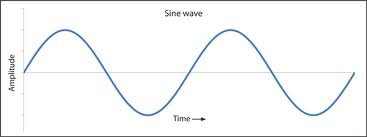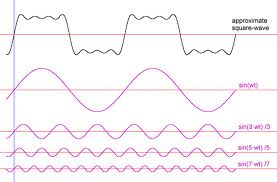Harmonics
What are Harmonics?
A signal or wave that contains just one frequency is a pure sine wave.

If the signal has some other shape, it can be described as a series of signals are integer multiples of the fundamental frequencies. These Ďextraí signals areharmonics. Here is how we could make an approximate square wave from a series of harmonics.
This example below just shows three harmonics added to make a rough square wave. A more precise square wave will contain more harmonics, some of them in very small amounts.

The harmonics have the property that they are all periodic at the fundamental frequency; therefore the sum of harmonics is also periodic at that frequency. Harmonic frequencies are equally spaced by the frequency of the fundamental frequency and can be found by repeatedly adding that frequenc For example, if the fundamental frequency (first harmonic) is 50 Hz, the frequencies of the next harmonics are: 100 Hz (2nd harmonic), 150 Hz (3rd harmonic), 200 Hz (4th harmonic) etc.
The process of figuring out just what combination of harmonics will make a particular wave shape is called Fourier analysis, named after the French mathematician Joseph Fourier.
We always encounter harmonics continuously in everyday life, be it in the human voice or musical instruments, here is an example of the sound wave from a trumpet.

Itís the harmonics that provide the beautiful richness in the sound. Without harmonics, everything you hear would sound like a tuning fork.
Harmonics are a part of life in electrical circuits
At Zener our interest is in the electrical variety of the AC power line wave which starts out as the sinusoidal variety but may be distorted to some extent by the nature of the connected load. The harmonic distortion caused as a result can be mathematically described by Fourier analysis and broken down into simpler sinusoid waves and quantified in effect.
We encounter or take advantage of the various types of electric loads which cause harmonic distortion in our typical working day. Such activities as travelling by electric train, going to the office, factory or shopping centre all illuminated by fluorescent lights, using escalators, elevators, computers large and small, and the comfort we take for granted is delivered by air conditioning systems with their associated chillers, fans, pumps and cooling towers a great many of which are driven by variable speed drives.
All of these devices employ rectifiers and electronic semiconductor devices in their respective circuitry which will lead to various degrees of harmonic distortion. These effects can often be managed without a cost impact. As always, a good design takes a little thought.
We hear so much about harmonics. Is it a good thing or a bad thing and what can be done about it, and while we are at it where does Power Factor fit in?
OK power factor can be described in terms of harmonics but it is worthy of a few words of itís own. A good starting point is to get rid of some commonly held misconceptions such as low Power Factor requires more power to do the same work. Fact is this is not so Ė go back to your basic physics and see for yourself.
Still confused? Give the friendly engineers at Zener a ring or send us an email. We donít sell power factor correction so we donít have a conflict of interest, but we do endorse good housekeeping when it comes to Power Factor so rest assured we would be happy to help.

 Call us today on
Call us today on 

